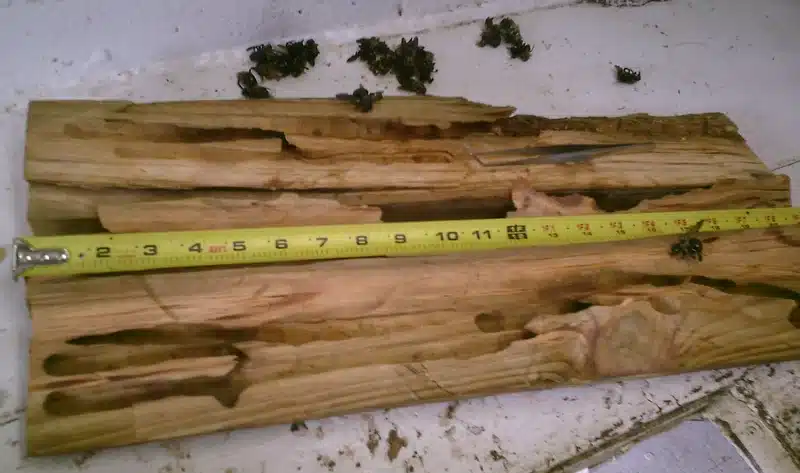You might think carpenter bee holes are just small cosmetic problems, but these perfectly round tunnels can become serious structural issues if left untreated. After four years treating carpenter bee problems across Virginia, Maryland, and DC, I’ve seen how these quarter-sized holes can turn into extensive gallery systems that weaken fascia boards, deck railings, and other wooden structures.
Our family business has handled carpenter bee issues for over 50 years throughout the DMV area. The most important thing homeowners need to understand is that carpenter bee holes aren’t random - they follow predictable patterns that help you identify, treat, and prevent future damage.
Understanding Carpenter Bee Damage
The large eastern carpenter bee, Xylocopa virginica, is the species causing structural damage throughout Virginia, Maryland, and DC. These bees are about ¾ to 1 inch long with a distinctive yellow fuzzy thorax and shiny black abdomen. Unlike termites or carpenter ants, carpenter bees create their damage by drilling directly into wood to build nests.
According to the University of Maryland Extension, carpenter bees have one generation per year. Adults emerge in April and May when temperatures hit around 70°F, which is when homeowners typically first notice the holes appearing.
The timing matters because early detection prevents years of accumulated damage. Each spring, female carpenter bees prefer to reuse existing holes rather than start fresh, gradually expanding tunnel systems that can eventually compromise structural integrity.
What Carpenter Bee Holes Look Like
Carpenter bee holes have a distinctive appearance that sets them apart from other wood damage. The entrance holes are perfectly round and measure 9-13 mm wide - about the size of your finger or what looks like it was drilled with a ½-inch bit.
The edges are remarkably smooth and clean, unlike the rough, splintered appearance of woodpecker holes or the mud-covered openings of termite activity. This precision comes from the female bee’s powerful jaws that can chew through softwood with surgical accuracy.
Fresh carpenter bee holes often have coarse sawdust piles directly underneath them. This frass looks like small wood “noodles” rather than the fine powder you’d see from other wood-boring insects. Additionally, you might notice yellowish-brown staining on the wood surface below holes where bees have left waste materials.
Common Locations for Carpenter Bee Holes
Carpenter bees target specific areas of your home where exposed softwood is readily available. The most common locations include:
- Fascia and rake boards along rooflines
- Deck railings and support posts
- Wooden porch ceilings and overhangs
- Exterior trim around windows and doors
- Wooden siding, especially cedar and pine
- Fence posts and outdoor furniture
In areas like McLean and Vienna with abundant tree cover, I’ve noticed carpenter bees particularly favor unpainted cedar and pine structures. They avoid hardwoods like oak or maple, preferring softer materials that are easier to excavate.

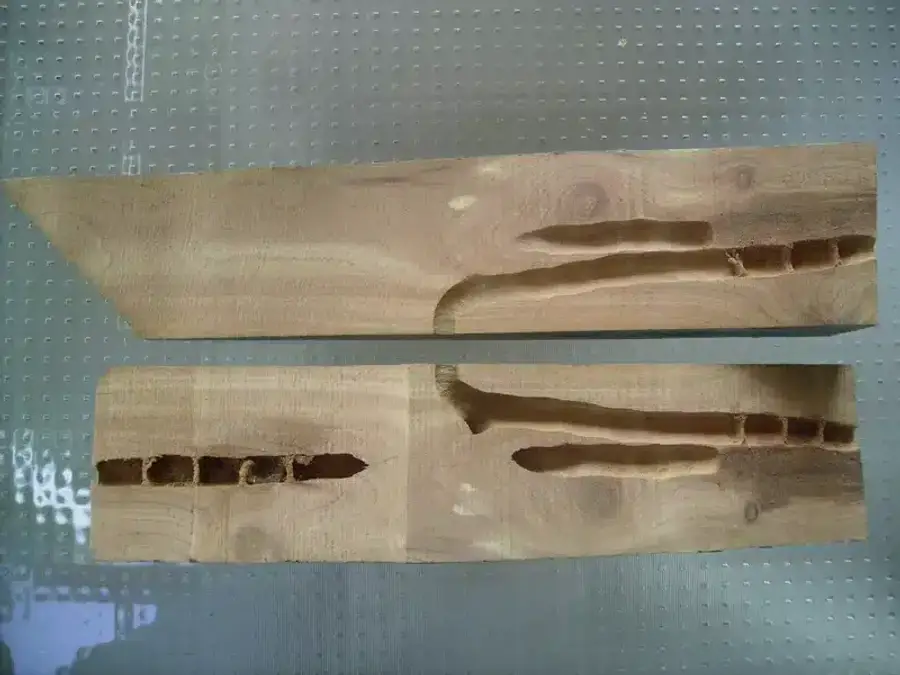
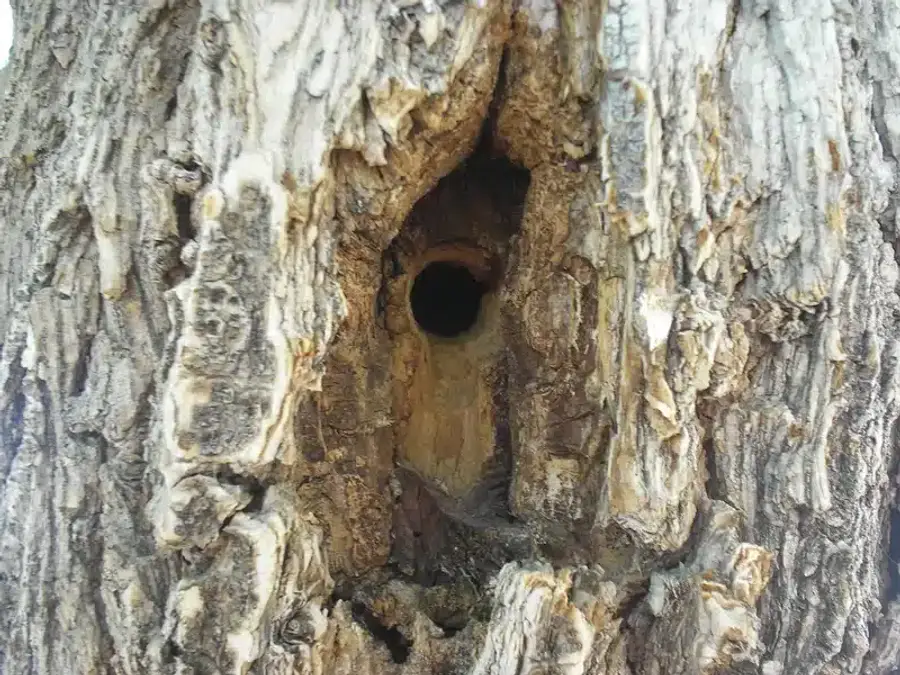
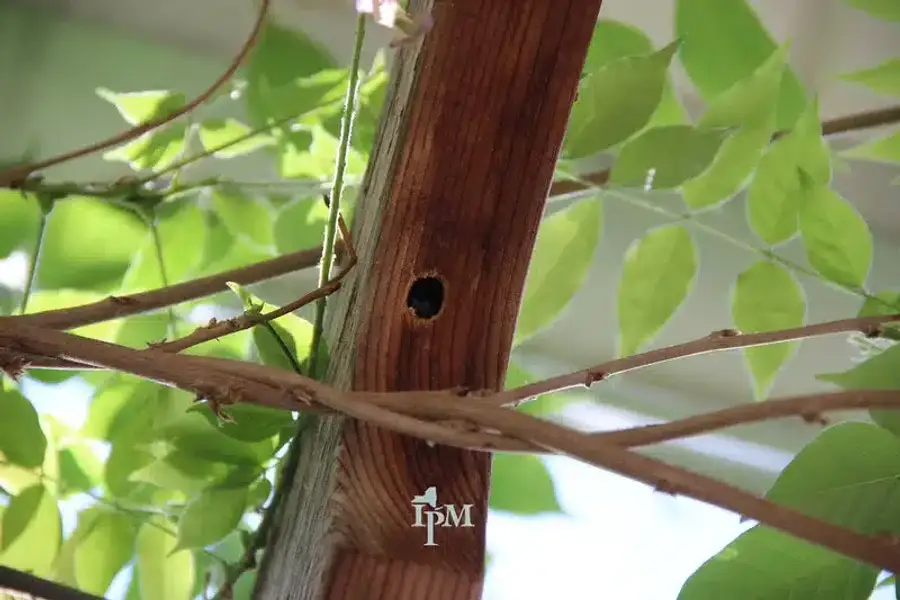
Weather-exposed lumber is their favorite target because it’s typically unpainted or the paint has worn thin. This is why fascia boards and deck railings get hit so frequently - they’re prime real estate for nesting females.
Gallery Structure Inside Wood
The real damage happens inside the wood where you can’t see it. Female carpenter bees create an intricate gallery system that starts with the visible entrance hole but extends far into the lumber.
After drilling the round entrance hole about 1-2 inches straight into the wood, the bee makes a 90-degree turn and tunnels along the wood grain. New galleries typically measure 4-6 inches long, but reused systems can reach 12 inches or more.
Inside these tunnels, female bees create 6-14 individual brood cells. Each cell gets provisioned with a ball of pollen and nectar called “bee bread,” then sealed with chewed wood pulp. This is where the next generation develops over the summer months.
The most concerning cases involve multi-generation gallery systems. In extreme situations, I’ve encountered interconnected tunnel networks measuring up to 10 feet in length, which can seriously compromise the structural integrity of smaller lumber pieces.
Signs of Active Carpenter Bee Holes
Determining whether carpenter bee holes are currently active helps prioritize your treatment approach. Active holes show several telltale signs:
Fresh sawdust appears regularly below the opening, often sticking to spider webs or accumulating on horizontal surfaces underneath. This frass has a distinctive coarse texture and light wood color when it’s freshly produced.
You’ll hear audible buzzing or rasping sounds coming from inside the wood, especially during morning hours when females are actively excavating. This sound can travel through walls and beams, making it seem like the noise is coming from multiple locations.
Visual confirmation comes from watching bees enter and exit the holes during daylight hours. Active sites also show yellowish-brown staining around the entrance where bees have deposited waste materials.
A simple test involves gently inserting a flexible wire into the hole. If you encounter resistance or movement, there’s likely a live bee inside the gallery.
Active vs Abandoned Carpenter Bee Holes
Distinguishing between active and abandoned carpenter bee holes affects your treatment strategy and helps assess damage potential. Abandoned holes have specific characteristics:
The entrance edges appear weathered and may have spider webs across the opening. No fresh sawdust accumulates below these holes, and any old frass has been washed away by rain.
When you insert a probing wire into abandoned holes, it moves freely through the gallery without encountering live insects. These old tunnels often collect debris or become home to other small insects.
Active holes require immediate treatment while abandoned ones need sealing to prevent reuse next season. However, both types indicate that your property has conditions attractive to carpenter bees, so comprehensive prevention becomes important.
The challenge is that holes can switch from abandoned to active when new bees discover and reoccupy old gallery systems. This is why checking all visible holes annually helps catch problems early.
Male vs Female Carpenter Bee Behavior
Understanding the different roles of male and female carpenter bees helps explain what you’re seeing around the holes. Males are responsible for the dramatic defensive behavior that typically brings carpenter bees to homeowners’ attention.
Male carpenter bees hover territorially around nest sites and perform aggressive “dive-bombing” flights toward anything that approaches. Despite this intimidating behavior, males cannot sting and pose no physical threat.
Females do the actual work of creating carpenter bee holes and galleries. They’re typically docile and focused on nest construction, rarely showing aggressive behavior unless directly handled. Female carpenter bees can sting but generally only do so when trapped or squeezed.
The territorial male behavior peaks during warm, sunny mornings in late spring and early summer. This is often when homeowners first notice carpenter bee activity, even though the females may have been quietly working on galleries for weeks.
Annual Reuse and Expansion
One of the most important aspects of carpenter bee holes is their reuse potential. Existing galleries are valuable real estate that gets passed down and expanded year after year.
Each spring, newly emerged females scout for nesting sites and strongly prefer to enlarge existing tunnels rather than start from scratch. This means a small 4-inch gallery can become a 12-inch tunnel system in just two seasons.
Multiple females may use the same entrance hole, creating branching galleries that spread through the lumber like underground subway systems. Successive generations can gradually extend tunnel length and add new lateral branches, compounding structural damage.
The cumulative effect becomes serious when multiple holes cluster in the same board or beam. I’ve seen deck railings and fascia boards that became so hollowed out they needed complete replacement after years of carpenter bee reuse.
Structural Damage Potential
While a single season of carpenter bee activity rarely compromises lumber strength, the long-term damage potential is significant. Years of reuse combined with tunnel expansion can weaken critical structural elements like fascia boards, deck supports, and log home components.
The damage gets amplified by woodpecker activity. These birds can acoustically locate carpenter bee larvae inside galleries and hack rectangular holes into the wood to reach them. Woodpecker damage often causes more extensive repair needs than the original bee tunnels.
Clustering effects multiply the problem when multiple carpenter bee holes appear in the same board. A 2x4 deck railing with three or four active gallery systems loses substantial structural integrity and may fail under normal load conditions.
Critical assessment points include checking for spongy wood texture, visible cracks radiating from holes, and any boards that flex abnormally when pressure is applied. These indicate that carpenter bee damage has progressed beyond cosmetic issues.
Optimal Treatment Timing
Successful carpenter bee hole treatment depends heavily on timing. There are two high-success windows that dramatically improve control results.
Late summer through early fall (August-September) offers the best treatment opportunity. New adult bees have emerged from galleries but haven’t yet entered winter dormancy. Treating during this period eliminates the overwintering population before next spring’s nesting activity.
The second window occurs in very early spring (late March through early April) before females start new excavation. This timing catches overwintering adults before they begin expanding galleries or creating new holes.
Daily timing also matters significantly. Individual hole treatments work best at dusk or nighttime when adult bees have returned to their galleries. Daytime treatments often miss the target insects entirely since they’re out foraging or defending territory.
Avoid treatments during peak flowering seasons when bees are most active as pollinators. This aligns with responsible pest management practices that protect beneficial insect populations while targeting only structural damage.
Treatment Methods for Carpenter Bee Holes
Professional treatment approaches focus on reaching bees deep within gallery systems while using products that minimize environmental impact. Residual dusts provide the most effective long-term control because they cling to insects and reach throughout tunnel networks.

Borate-based dusts, pyrethroid formulations, and silica aerogels can be injected into holes using a hand duster. These materials contact bees as they move through galleries and provide extended protection against reuse.
Contact sprays offer quick knockdown for galleries less than 4 inches deep but don’t reach insects in longer tunnel systems. Aerosol products work best for immediate control when combined with dust applications for residual activity.
Mechanical control methods include probing galleries with flexible wire to physically remove larvae, vacuuming out tunnel contents, or installing bee-proof netting over valuable wooden structures. These approaches work well for homeowners who prefer non-chemical options.
Our approach emphasizes pollinator-conscious applications that target only structural wood while avoiding flowering plants. We time treatments when bees are inside tunnels and use EPA-approved products that have passed through our internal research team review.
Proper Hole Sealing After Treatment
Timing is critical for effective hole closure. After applying dust treatments, leave carpenter bee holes open for 24-72 hours to ensure maximum contact with any remaining insects.
Premature sealing can trap live bees inside galleries, leading to continued tunneling or emergency exit holes in unexpected locations. The waiting period allows treated insects to exit while still contacting the residual material.
For permanent closure, several materials work effectively:
- Outdoor wood filler for small holes in painted surfaces
- Marine-grade epoxy for high-moisture locations
- Exterior caulk for flexible sealing around moving joints
- Hardwood dowels glued flush for structural repairs
After filling holes, sand the surface smooth and apply primer followed by two coats of exterior paint. This repair process not only closes access points but helps prevent new drilling attempts in the same area.
Preventing New Carpenter Bee Holes
Paint protection is your best defense against new carpenter bee holes. Studies consistently show that fully painted softwood lumber rarely gets attacked, while unpainted or stained wood remains highly attractive to nesting females.
Solid-body exterior paints create a barrier that carpenter bees find difficult to penetrate. Semi-transparent stains offer minimal protection because they don’t create a thick enough surface layer to deter drilling attempts.
For vulnerable areas like deck railings and fascia boards, consider replacing severely damaged sections with alternative materials:
- Pressure-treated lumber with solid stain
- PVC or composite trim pieces
- Fiber-cement boards in high-attack zones
- Aluminum or vinyl cladding systems
Hardwood substitution works well for trim applications where aesthetics allow. Oak, maple, and other dense woods resist carpenter bee attacks because they’re too difficult to excavate efficiently.
Regular maintenance includes touching up paint on nail holes, knots, and weathered areas where the protective coating has thinned. These spots often become starting points for new carpenter bee holes.
When Wood Replacement Becomes Necessary
Several indicators signal that carpenter bee holes have progressed beyond treatable limits. Structural compromise occurs when lumber feels spongy, shows visible cracks radiating from holes, or flexes abnormally under normal pressure.
Woodpecker damage that exposes interior framing elements usually requires board replacement rather than repair. These rectangular excavations remove too much material for effective patching while leaving the remaining wood vulnerable to moisture infiltration.
Hole density thresholds help guide replacement decisions. When more than 10 active carpenter bee holes appear per linear foot of lumber, the structural integrity becomes questionable even if individual galleries aren’t extremely long.
Replacement material choices should reflect lessons learned from the original damage. Composite decking, PVC trim, and pre-painted fiber-cement products eliminate future carpenter bee problems while often providing better long-term durability than traditional wood options.
Cost analysis sometimes favors replacement over repeated annual treatments plus cosmetic repairs. A single investment in carpenter bee-resistant materials can provide decades of protection compared to ongoing maintenance expenses.
Long-Term Management Strategy
Successful carpenter bee hole management requires an integrated approach that combines monitoring, prevention, and targeted treatment. Annual spring inspections using a flashlight and mirror help identify new activity before extensive damage occurs.
Keep detailed records of hole locations and treatment dates. This information helps identify patterns in carpenter bee preferences and allows you to focus prevention efforts on high-risk areas.
Maintain exterior paint schedules on 4-6 year cycles with annual touch-ups on vulnerable spots like fascia boards and deck railings. Spot-prime any nail holes, knots, or weathered areas where protective coating has deteriorated.
For chronic problem areas, consider installing pre-painted aluminum flashing strips along fascia edges or switching to composite trim materials that eliminate the wood substrate entirely.
The goal should be targeted management rather than blanket elimination since carpenter bees serve as important native pollinators. Focus control efforts on structural wood while maintaining habitat for these beneficial insects in non-damaging locations.


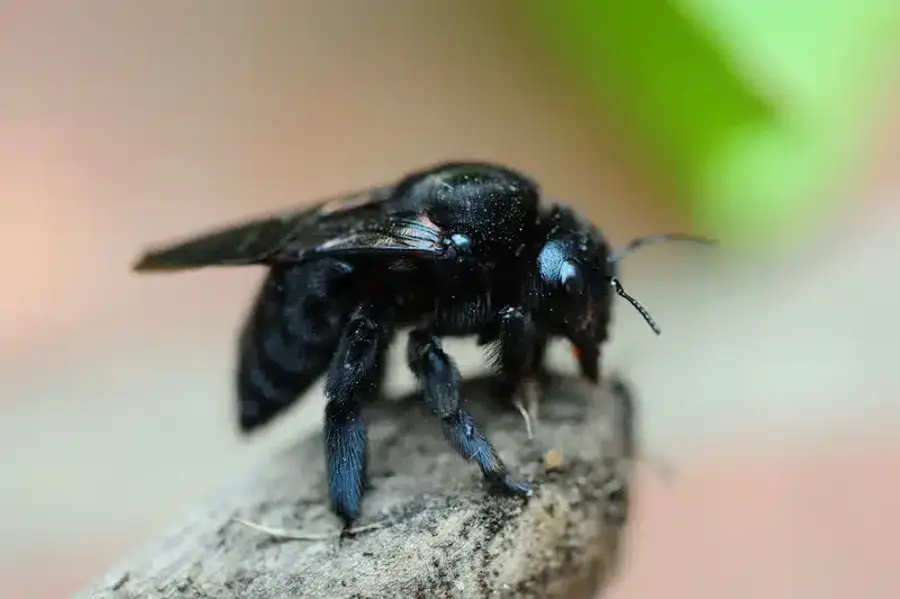
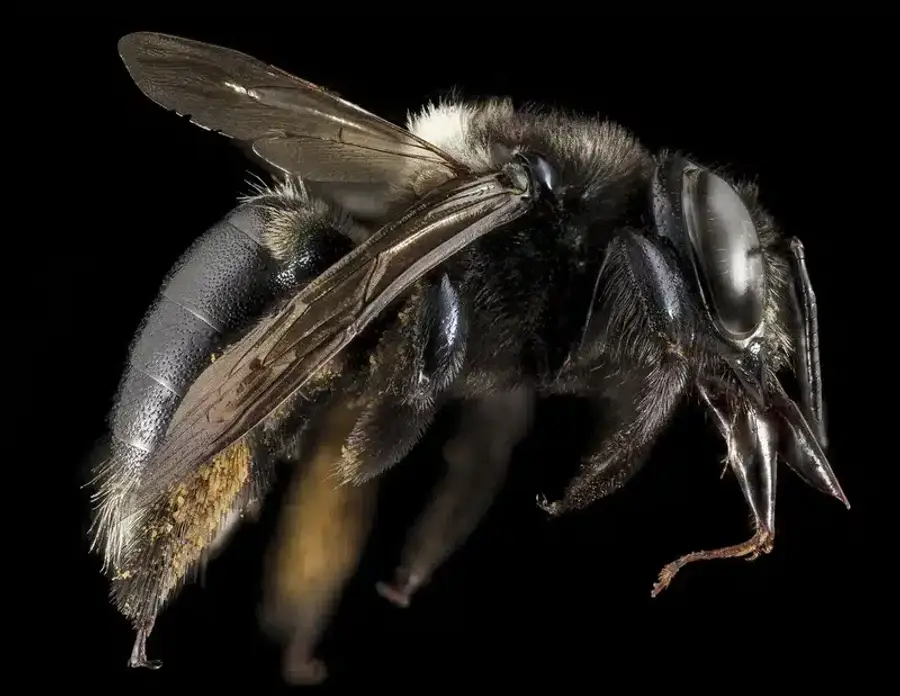
Professional Assessment and Treatment
As a registered technician with a third-generation family business serving the DMV area for over 50 years, I’ve developed systematic approaches to carpenter bee hole problems that address both immediate damage and long-term prevention.
Our treatment protocols emphasize products that have passed through our internal research team review, eliminating 9 chemicals commonly used in the industry. Materials like Essentria, Alpine, and borate-based solutions provide effective control while meeting our strict standards for family and environmental responsibility.
The Better Method starts with expert phone consultation where licensed technicians provide detailed quotes based on your specific situation. Our 78-point home inspection identifies both active carpenter bee holes and conditions that attract future infestations.
Treatment timing follows proven protocols that maximize contact with target insects while minimizing impact on beneficial pollinators. We coordinate carpenter bee treatments with comprehensive pest management that addresses related issues like carpenter ants and wood-boring beetles.
Follow-up services include annual reviews to monitor treatment effectiveness and adjust prevention strategies based on changing conditions around your property.
If you’re dealing with carpenter bee holes or want to prevent them from becoming a problem, our licensed technicians can provide targeted solutions that protect your property investment. Contact us at 703-683-2000 or email info@bettertermite.com for a detailed assessment of your specific situation.
Frequently Asked Questions
What do carpenter bee holes look like exactly?
+
Carpenter bee holes are perfectly round openings about ⅜ to ½ inch wide with smooth, clean edges that look like they were made with a drill bit. Fresh holes have coarse sawdust piles directly underneath and may show yellowish-brown staining on the surrounding wood surface.
How can I tell if carpenter bee holes are still active?
+
Active carpenter bee holes show fresh sawdust accumulation, yellowish stains around the opening, and audible buzzing sounds from inside the wood. You can also probe gently with a flexible wire - if you feel resistance or movement, there's likely a live bee inside the gallery.
Will carpenter bee holes cause serious structural damage to my home?
+
One season of carpenter bee activity rarely compromises structural integrity, but repeated reuse and expansion of galleries can weaken fascia boards, deck railings, and other lumber over time. Woodpecker damage that follows can cause more extensive destruction than the original bee tunnels.
What's the best time to treat carpenter bee holes?
+
The most effective treatment windows are late summer through early fall (August-September) after new adults emerge, and very early spring (late March-early April) before nesting activity begins. Daily timing should focus on dusk or nighttime when bees are inside their galleries.
How do I properly seal carpenter bee holes after treatment?
+
Wait 24-72 hours after applying dust treatments before sealing holes to ensure contact with remaining bees. Use outdoor wood filler, marine-grade epoxy, or exterior caulk depending on the location, then sand smooth and apply primer plus two coats of exterior paint.
Can painting really prevent new carpenter bee holes?
+
Solid-body exterior paints provide excellent protection against carpenter bee drilling attempts. Fully painted softwood lumber rarely gets attacked, while semi-transparent stains offer minimal deterrent value because they don't create a thick enough barrier.
Are there non-chemical ways to control carpenter bee holes?
+
Mechanical control methods include probing galleries with wire to remove larvae, vacuuming tunnel contents, installing bee-proof netting, or replacing vulnerable wood with PVC, composite, or metal alternatives. These approaches work well for homeowners preferring chemical-free options.
When should I replace wood instead of treating carpenter bee holes?
+
Replace lumber when it feels spongy or shows cracks radiating from holes, when woodpecker damage exposes framing, or when more than 10 active galleries appear per linear foot. Severely compromised wood requires replacement rather than repair for structural integrity.
How long do carpenter bee treatments typically last?
+
Professional dust treatments can provide control for one full season when applied correctly. However, comprehensive management requires annual monitoring since new carpenter bees may discover treated areas or reuse old galleries that weren't completely eliminated.
Do carpenter bees return to the same holes every year?
+
Yes, carpenter bees strongly prefer to reuse and expand existing galleries rather than start new holes. This annual reuse pattern means untreated holes typically get larger and more damaging each season, making early intervention important for preventing serious structural issues. For comprehensive carpenter bee hole assessment and treatment solutions tailored to your property, contact Better Termite & Pest Control at 703-683-2000 or email us at info@bettertermite.com. Our licensed technicians provide expert consultation and proven treatment methods that protect your home while respecting beneficial pollinator populations.
With five years of hands-on experience in the pest control industry, George Schulz is a registered technician with the Virginia Pest Management Association and a proud third-generation professional in a family business that's been protecting homes for over 57 years. He manages and trains a team of service pros while also leading internal research efforts—recently spearheading a deep-dive review of thousands of documents on pest control materials to hand-pick the most kid and pet friendly, most effective solutions tailored specifically for homes in the DC metro area.
